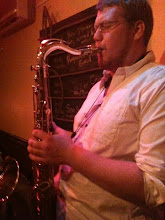I am very fortunate. I grew up in a household where jazz was being played all of the time. I grew up on Zoot Sims, Lester Young, Coleman Hawkins, Sonny Rollins, Count Basie, Duke Ellington and Oscar Peterson and as I grew older my tastes expanded and I started getting into Dave Liebman, Joe Lovano, Steve Grossman, Bill Evans, Bob Brookmeyer, Michael Brecker and so many others.
I have been thinking quite a bit about influence, and lineage because my students are developping into players. I have a grade 9/10 big band that I lead in Ottawa. Every rehearsal I walk into the room, and ask "So what's everybody been listening to?" There are some great answers - Miles Davis - Nefertitti, Michael Brecker, the RH Factor, Arturo Sandoval, and so many other artists. I'll ask "Does anybody know who Johnny Hodges is? or Clifford Brown? or Don Byas?"
The answer is generally "no", except for my students - because listening is a huge part of my lessons, and I can even think it's unfair that I ask. Unless you grow up in a jazz household, you probably don't know a lot of the names that I would bring up - especially as a 13 or 14 year old who's just getting into the music.
I believe that it is important to know the lineage of your instrument - the players and the physical instrument itself, and the music.
The lineage of your instrument is important from the player standpoint, because you begin to hear the influence. You can understand why and how a player draws from the players before him/her. Listen to Lew Tabackin for not just the Coleman Hawkins, but the Don Byas and the Sonny Rollins in his sound, phrasing and lines. If you talk to players who are new to the soprano saxophone, they are indebted to John Coltrane, but what about Steve Lacy?
If you think of the history of an instrument, you can figure out why players played the way they did. Especially on the saxophone, the invention of left-hand pinky-rollers was a huge innovation. Before they were invented moving around that key cluster was very awkward. Have you ever owned a Buescher True Tone? That was one of the reasons for me to switch off of them. The ergonomics were awkward on that part of the horn. This is just one example. But you could relate that to the reason players from that period didn't spend that much time around that end of the saxophone.
Another point to touch on is style. How was an eighth note played in 1925? '45? '65? '85? today? What kind of vibrato was in style?
The reason that I think that lineage is so important, is because it creates an active listener. When you start understanding nuances in sound, rhythm, texture, etc. You integrate what you like into your playing concept and taking something from the greats can't hurt.
It's incredible to watch my students hear the influence another player has on another - they then find out what they want to sound like. They develop a concept for their sound. They feel time in different ways. To me, it all comes down to active listening.
What do you think about these clips? What do you like? What catches your ear? Can you hear the influence?
Body and Soul
Coleman Hawkins
Dexter Gordon
John Coltrane
Michael Brecker
Chris Potter
What do you like? What catches your ear? Can you hear the influence?
Subscribe to:
Post Comments (Atom)

No comments:
Post a Comment